-
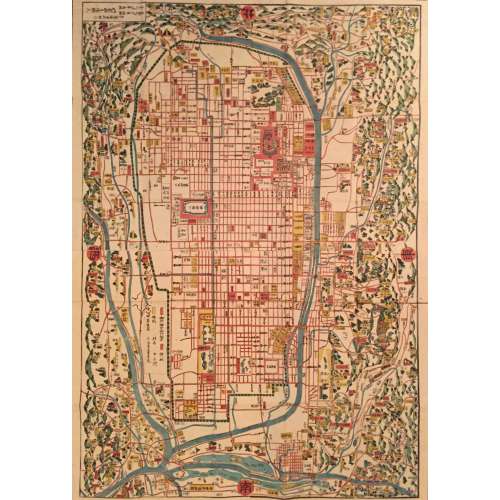
-
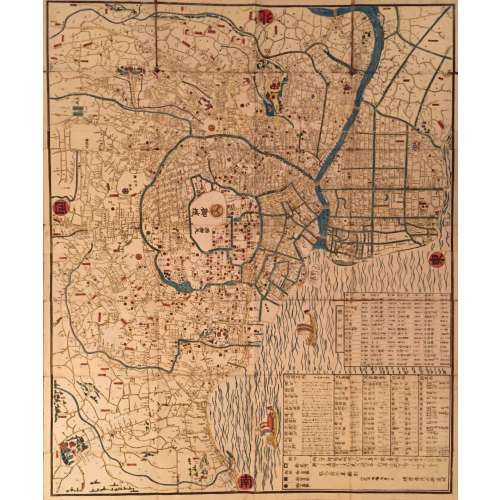
-
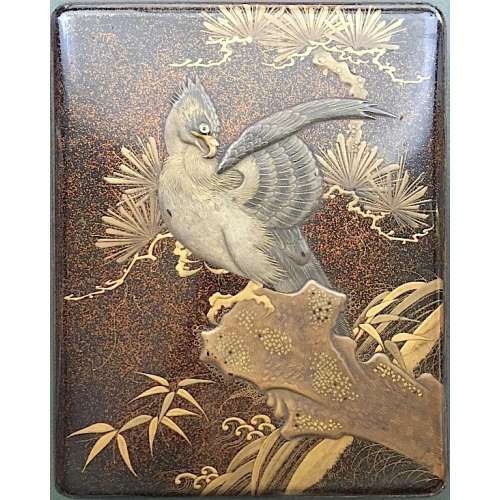 Japanese lacquer writing box (suzuribako) with an eagle sitting on a pine tree over the see waves. Rectangular box with rounded corners, slightly convex overlapping lid. Lacquer on wood with maki-e decoration in gold powder. The lid decorated inside with pine cones and needles over gold maki-e. Edo or Meiji period, 19th century.
Japanese lacquer writing box (suzuribako) with an eagle sitting on a pine tree over the see waves. Rectangular box with rounded corners, slightly convex overlapping lid. Lacquer on wood with maki-e decoration in gold powder. The lid decorated inside with pine cones and needles over gold maki-e. Edo or Meiji period, 19th century. -
 Woman Looking out a Round Window at a Woman with a Komusō Hat.
Woman Looking out a Round Window at a Woman with a Komusō Hat.Artist Koikawa Harumasa (a.k.a. Banki): fl. 1801–18. Wikipedia: Koikawa Harumasa (恋川 春政; active 1800–1820), later called Banki Harumasa (晩器 春政). Associated with Katsukawa school.
Signed: Banki ga (on the bamboo flower container in the background). Censor's seal: kiwame. Mark of unidentified publisher, Genshoku #1017; Marks U084 Ibiko, p. 387.
References:
Jacob Pins #828.
-
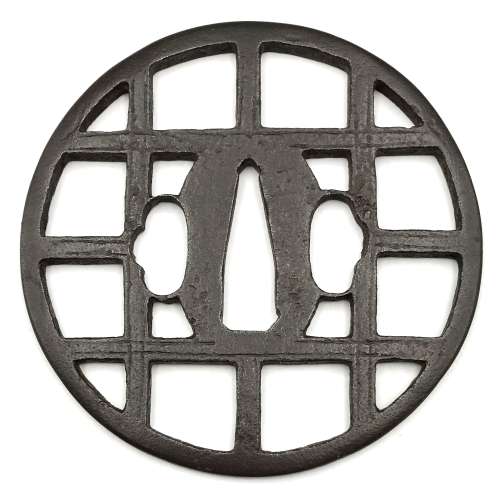 Iron tsuba of round form with design of lattice (kōshi-mon, 格子文) cut in openwork (sukashi), with low relief shallow linear carving along the bars. Well forged plate with brown-ish hue. To the right of nakago-ana there is a clear inscription of the character Shō (正), which is explained by Markus Sesko is follows: "The Shinsa obviously recognized more from the signature when having the tsuba in hand, i.e. they were confident to say it is signed "Shōami" but the rest is illegible (ika-fumei, 以下不明). That is, if they were just able to read the first character SHŌ (正) and saw that there were two more, most likely A (阿) and MI (弥), they would have put those character in boxes on the paper. Boxes around characters namely means that the character is not 100% legible but it can be assumed what it is." Momoyama or early Edo period. Dimensions: 85.9 mm diameter, 3.6 mm thickness at seppa-dai. Weight: 79 g. NBTHK certificate № 425069 with attestation: Hozon - "Worthy of preservation". A similar tsuba is presented at Japanese Sword Fittings from the R. B. Caldwell Collection. Sale LN4188 "HIGO". Sotheby's, 30th March 1994, №15. The description says: "A rare early Kamakura-bori tsuba. Nambokucho period (late 14th century). Of circular form, the dark plate carved and pierced with a gate design, the struts with double engraved lines. Unsigned. 8.5 cm." The lot was sold for 1,840 GBP.We have two possible explanations of the discrepancy between Sotheby's and Shinsa/Sesko attribution: 1) either Sotheby's or Shinsa/Sesko were wrong in their attribution or 2) these are two different pieces, one - Kamakura-bori from the 14th century and another - Shōami from 16th/17th century. Anyway, I would consider my piece as a Shōami tsuba of Momoyama - early Edo period, just for the sake of modesty.
Iron tsuba of round form with design of lattice (kōshi-mon, 格子文) cut in openwork (sukashi), with low relief shallow linear carving along the bars. Well forged plate with brown-ish hue. To the right of nakago-ana there is a clear inscription of the character Shō (正), which is explained by Markus Sesko is follows: "The Shinsa obviously recognized more from the signature when having the tsuba in hand, i.e. they were confident to say it is signed "Shōami" but the rest is illegible (ika-fumei, 以下不明). That is, if they were just able to read the first character SHŌ (正) and saw that there were two more, most likely A (阿) and MI (弥), they would have put those character in boxes on the paper. Boxes around characters namely means that the character is not 100% legible but it can be assumed what it is." Momoyama or early Edo period. Dimensions: 85.9 mm diameter, 3.6 mm thickness at seppa-dai. Weight: 79 g. NBTHK certificate № 425069 with attestation: Hozon - "Worthy of preservation". A similar tsuba is presented at Japanese Sword Fittings from the R. B. Caldwell Collection. Sale LN4188 "HIGO". Sotheby's, 30th March 1994, №15. The description says: "A rare early Kamakura-bori tsuba. Nambokucho period (late 14th century). Of circular form, the dark plate carved and pierced with a gate design, the struts with double engraved lines. Unsigned. 8.5 cm." The lot was sold for 1,840 GBP.We have two possible explanations of the discrepancy between Sotheby's and Shinsa/Sesko attribution: 1) either Sotheby's or Shinsa/Sesko were wrong in their attribution or 2) these are two different pieces, one - Kamakura-bori from the 14th century and another - Shōami from 16th/17th century. Anyway, I would consider my piece as a Shōami tsuba of Momoyama - early Edo period, just for the sake of modesty.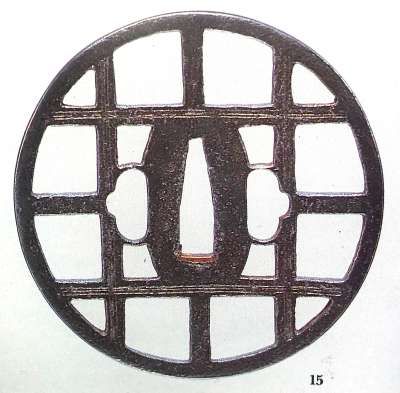
Caldwell Collection. Sotheby's 1994, №15.
-
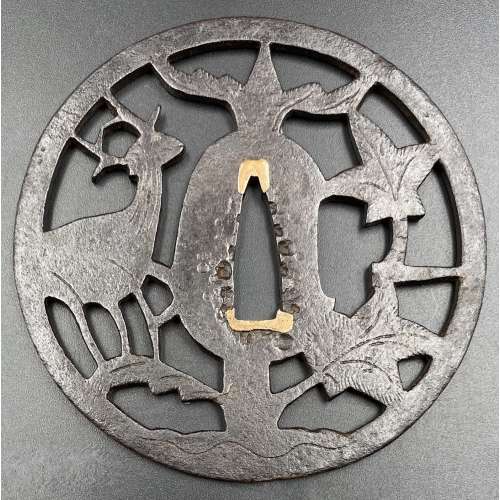
Iron tsuba of round form decorated with a deer and maple leaves in positive silhouette openwork (ji-sukashi), with details finely carved in low relief (kebori). Nakagō-ana plugged with copper fittings (sekigane). Traces of lacquer on the surface.
NBTHK: Hozon, №424947.
Design: An autumnal tsuba with an allusion to Kasuga Shrine in Nara.
Attributed by NBTHK to Shoami. Age: Probably the Momoyama period (1574 – 1603) or early Edo period (1603 – 1650), but judging on the item's substantial size (diameter 86.6 mm) and considerable thinness (3.4 mm) may be attributed to earlier times (late Muromachi period, 1514 – 1573). -
 Ebisu drawing wakamizu, the first water drawn from a well on the New Year. Kitao Shigemasa (北尾 重政, 1739 – 8 March 1820). Signed: Shigemasa. Publisher's mark: Nishimuraya Yohachi.
Ebisu drawing wakamizu, the first water drawn from a well on the New Year. Kitao Shigemasa (北尾 重政, 1739 – 8 March 1820). Signed: Shigemasa. Publisher's mark: Nishimuraya Yohachi.References:
Jacob Pins #547 [p.217] - Ebisu drawing wakamizu, the first water drawn from a well on the New Year. TNM II (Tokyo National Museum Catalogue vol. 2) #1373.
-
 Santō Kyōden (山東 京伝, September 13, 1761 Edo – October 27, 1816) was a Japanese poet, writer and artist in the Edo period. He studied ukiyo-e under master Kitao Shigemasa (北尾 重政) [see SVJP-0006], and began illustrating kibyōshi under the pseudonym of Kitao Masanobu (北尾 政寅).
Santō Kyōden (山東 京伝, September 13, 1761 Edo – October 27, 1816) was a Japanese poet, writer and artist in the Edo period. He studied ukiyo-e under master Kitao Shigemasa (北尾 重政) [see SVJP-0006], and began illustrating kibyōshi under the pseudonym of Kitao Masanobu (北尾 政寅).Signed: Masunobu ga.
"Parody of the Nō Play Chōryō" (elsewhere) or "Parody of Huáng Shigōng and Zhāng Liáng" (David Waterhouse, The Harunobu Decade, Hotei Publishing, 2013, v. 2, №651). "The story [...] is about an encounter between the Chinese government minister Chôryô (Zhāng Liáng) and the legendary elder Kôsekikô (Huáng Shigōng) in the 3rd century BC. While riding a mule across a bridge, Kôsekikô dropped his sandal. Chôryô returned it to him. As a reward, Kôsekikô gave Chôryô a book of military strategy. Later, Chôryô helped to establish the Han Dynasty (207 BC-AD 220)." [The Walters Art Museum]References:
Waterhouse, The Harunobu Decade (2013), #651; Ukiyo-e shûka supp. 2 (1982), pl. 625; Pins, The Japanese Pillar Print (1982), #274/p.145; J. Kurth, Die Geschichte..., vol. II, Leipzig, 1928; S. Kikuchi, Ukiyo-e, 1966.
-
 Artist: Kitagawa Utamaro [喜多川 歌麿] (Japanese, c. 1753 – 1806) "This uncommon half-size horizontal ōban ... is most likely one design from a set of twelve prints issued late in Utamaro's life" [Japanese Erotic Fantasies, Hotei Publishing, 2005, p. 143, pl. 47]. Half-size horizontal ōban must be 12.7 x 38 cm. Richard Waldman and Chris Uhlenbeck say it's tanzaku size (13 x 43 cm). In reality, the prints of this series measure 17 x 38 cm, which corresponds exactly to horizontal o-hosoban paper size. I managed to assemble 11 of allegedly 12 designs. 7 of them have genitals colored by hand. It's hard to tell whether it was done by the publisher on demand of a peculiar buyer, or by the owner of the prints who considered the black and white privy parts unnatural. My sequencing of the prints is arbitrary. Transcription of the text may help find the correct order.
Artist: Kitagawa Utamaro [喜多川 歌麿] (Japanese, c. 1753 – 1806) "This uncommon half-size horizontal ōban ... is most likely one design from a set of twelve prints issued late in Utamaro's life" [Japanese Erotic Fantasies, Hotei Publishing, 2005, p. 143, pl. 47]. Half-size horizontal ōban must be 12.7 x 38 cm. Richard Waldman and Chris Uhlenbeck say it's tanzaku size (13 x 43 cm). In reality, the prints of this series measure 17 x 38 cm, which corresponds exactly to horizontal o-hosoban paper size. I managed to assemble 11 of allegedly 12 designs. 7 of them have genitals colored by hand. It's hard to tell whether it was done by the publisher on demand of a peculiar buyer, or by the owner of the prints who considered the black and white privy parts unnatural. My sequencing of the prints is arbitrary. Transcription of the text may help find the correct order. As Japanese Erotic Fantasies put it: "a couple engaged in love-making, their stare fixed outside the picture plane". This is the only image of series that has a reference in available western literature, and the only one found in museum collections: Rijksmuseum Amsterdam (RP-P-1999-2001-16); reference: Fukuda (ed.) (1990), pls. 11-2.
As Japanese Erotic Fantasies put it: "a couple engaged in love-making, their stare fixed outside the picture plane". This is the only image of series that has a reference in available western literature, and the only one found in museum collections: Rijksmuseum Amsterdam (RP-P-1999-2001-16); reference: Fukuda (ed.) (1990), pls. 11-2.
 The scene of this print looks quite similar to that of the Kiyonaga's Sode no maki:
The scene of this print looks quite similar to that of the Kiyonaga's Sode no maki:
 The woman is "a young lady-in-waiting of Shogun's Court or Daimyō's Mansion, enjoying a rare outing from her tedious chores" [Richard Lane]. She is fully dressed in her outer cloak (shikake), white paper hat (agebōshi or tsunokakushi), and toed socks (tabi). A book or maybe, onkotogami (roll of tissues known as 'paper for honourable act' ) is still in the folds of her kimono. She is holding an open fan, either to cover her and her lover's faces from an unsolicited witness or to bring some fresh air to their joined lips. The pair just started their sexual intercourse.
The woman is "a young lady-in-waiting of Shogun's Court or Daimyō's Mansion, enjoying a rare outing from her tedious chores" [Richard Lane]. She is fully dressed in her outer cloak (shikake), white paper hat (agebōshi or tsunokakushi), and toed socks (tabi). A book or maybe, onkotogami (roll of tissues known as 'paper for honourable act' ) is still in the folds of her kimono. She is holding an open fan, either to cover her and her lover's faces from an unsolicited witness or to bring some fresh air to their joined lips. The pair just started their sexual intercourse.
 A scene from medieval times. A courtier in eboshi cap having sex with an aristocratic young woman with a long straight hairstyle (suihatsu).
A scene from medieval times. A courtier in eboshi cap having sex with an aristocratic young woman with a long straight hairstyle (suihatsu).
 Completely naked couple in the moment of ejaculation. Lavish garments with paulownia leaves on a yellow background counterbalance the white bodies on red bedding. The form of a woman's cheeks is telling, but I don't know about what. Maybe her advanced age?
Completely naked couple in the moment of ejaculation. Lavish garments with paulownia leaves on a yellow background counterbalance the white bodies on red bedding. The form of a woman's cheeks is telling, but I don't know about what. Maybe her advanced age?
 The pose of the couple and the overall composition are similar to that of the previous sheet. Though the lovers are dressed, and the woman's hairdo is well kept. The male looks older and the woman - younger.
The pose of the couple and the overall composition are similar to that of the previous sheet. Though the lovers are dressed, and the woman's hairdo is well kept. The male looks older and the woman - younger.
 A man takes a young maid from behind. She clenches the sleeve of her kimono in her teeth; it's either the moment of penetration (beginning of intercourse) or of her orgasm (the end of it).
A man takes a young maid from behind. She clenches the sleeve of her kimono in her teeth; it's either the moment of penetration (beginning of intercourse) or of her orgasm (the end of it).
 This seems to be a forced intercourse between a lackey with extensive bodily hair and a young maid from the same household.
This seems to be a forced intercourse between a lackey with extensive bodily hair and a young maid from the same household.
 This design is very much like the other one presented below, which is described at Japanese Erotic Fantasies on page 136 (pl. 43b) as follows: "The viewer peers through a mosquito net to see a child fast asleep, while his mother or wet-nurse moves towards her partner. On our print there is no child; instead of a sleeping baby, there is a roll of onkotogami. Fewer objects make the overall image concise, almost laconic in comparison with the Ehon hana fubuki (1802) design:
This design is very much like the other one presented below, which is described at Japanese Erotic Fantasies on page 136 (pl. 43b) as follows: "The viewer peers through a mosquito net to see a child fast asleep, while his mother or wet-nurse moves towards her partner. On our print there is no child; instead of a sleeping baby, there is a roll of onkotogami. Fewer objects make the overall image concise, almost laconic in comparison with the Ehon hana fubuki (1802) design:

 A young couple in a moment of true love. He is listening to the beating of her heart.
A young couple in a moment of true love. He is listening to the beating of her heart.
 This is a moment of true love between an old monk and a young samurai. The latter even did not take of his socks (tabi).
This is a moment of true love between an old monk and a young samurai. The latter even did not take of his socks (tabi).
 From Japanese Erotic Fantasies: "Boats played a crucial role in the workings of Yoshiwara, as they were the primary means of transport to the district. During the hot summer months, trips on pleasure boats were also a favourite pastime. Sex aboard a boat is a recurrent theme in shunga".
The last print that I am currently lacking and hunting for:
From Japanese Erotic Fantasies: "Boats played a crucial role in the workings of Yoshiwara, as they were the primary means of transport to the district. During the hot summer months, trips on pleasure boats were also a favourite pastime. Sex aboard a boat is a recurrent theme in shunga".
The last print that I am currently lacking and hunting for:
 I know where it is, but I cannot reach it... yet.
I know where it is, but I cannot reach it... yet. -
 Kitagawa Utamaro. Illustration from the book Ehon koi no Onamaki. Cited at Hayashi Yoshikazu's 20-volume set Edo makura-e shi shusei: Kitagawa Utamaro. Size: Chuban (25.5 x 18.5 cm), two book pages glued together.
Kitagawa Utamaro. Illustration from the book Ehon koi no Onamaki. Cited at Hayashi Yoshikazu's 20-volume set Edo makura-e shi shusei: Kitagawa Utamaro. Size: Chuban (25.5 x 18.5 cm), two book pages glued together. -
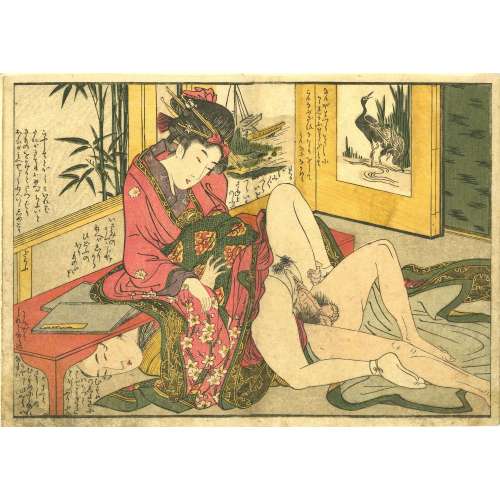 Kitagawa Utamaro. Illustration from book Ehon koi no Onamaki, published in 1799. Reference found by Chris Uhlenbeck: he found one of the designs in Hayashi Yoshikazu's 20-volume set Edo makura-e shi shusei: Kitagawa Utamaro. Size: Chuban (25.5 x 18.5 cm), two book pages glued together.
Kitagawa Utamaro. Illustration from book Ehon koi no Onamaki, published in 1799. Reference found by Chris Uhlenbeck: he found one of the designs in Hayashi Yoshikazu's 20-volume set Edo makura-e shi shusei: Kitagawa Utamaro. Size: Chuban (25.5 x 18.5 cm), two book pages glued together. -
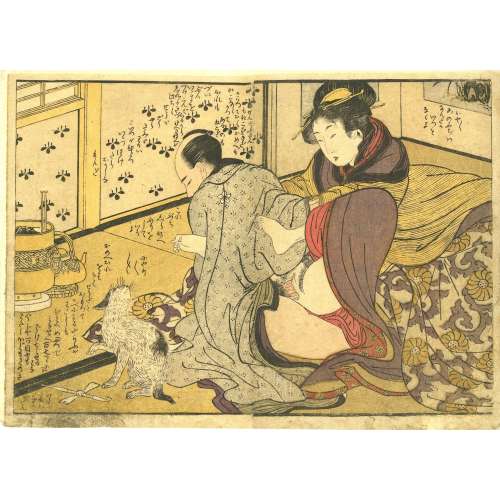 Kitagawa Utamaro. According to Chris Uhlenberg this is an illustration from the book Ehon koi no Onamaki, 3 vols, published in Kansei 11 (1799). Illustrated in b/w in: Hayashi Yoshikazu: Kitagawa Utamaro, in the series: Edo makura-e shi shusei, published in 1990, reissued 1994. Size: Chuban (25.5 x 18.5 cm), two book pages glued together.
Kitagawa Utamaro. According to Chris Uhlenberg this is an illustration from the book Ehon koi no Onamaki, 3 vols, published in Kansei 11 (1799). Illustrated in b/w in: Hayashi Yoshikazu: Kitagawa Utamaro, in the series: Edo makura-e shi shusei, published in 1990, reissued 1994. Size: Chuban (25.5 x 18.5 cm), two book pages glued together. -
 Kitagawa Utamaro (喜多川 歌麿; c. 1753 – 31 October 1806). Act III (Sandanme), from the series The Storehouse of Loyal Retainers (Chûshingura). Publisher Nishimuraya Yohachi (Eijudô). About 1801–02 (Kyôwa 1–2) Vertical ôban; 39.3 x 26 cm (15 1/2 x 10 1/4 in.). Reference: MFA ACCESSION NUMBER 11.14441 Ukiyo-e shûka 3 (1978), list #368.3; Shibui, Ukiyo-e zuten Utamaro (1964), 165.1.3; the series: Asano and Clark 1995, #s 383-5.
Kitagawa Utamaro (喜多川 歌麿; c. 1753 – 31 October 1806). Act III (Sandanme), from the series The Storehouse of Loyal Retainers (Chûshingura). Publisher Nishimuraya Yohachi (Eijudô). About 1801–02 (Kyôwa 1–2) Vertical ôban; 39.3 x 26 cm (15 1/2 x 10 1/4 in.). Reference: MFA ACCESSION NUMBER 11.14441 Ukiyo-e shûka 3 (1978), list #368.3; Shibui, Ukiyo-e zuten Utamaro (1964), 165.1.3; the series: Asano and Clark 1995, #s 383-5. -

Kitagawa Tsukimaro (Kikumaro): 喜多川 月麿, fl. c. 1794–1836.
Mother is playing with her child: they left playing with shadow lantern for freeing a turtle (Hojo-e, or "Rite for the Release of Living Beings").Signed: Tsukimaro hitsu (月麿筆); Publisher's mark; censor's seal: Kiwame + Yamaguchiya Tôbei gyōji seal (1811-14).
-
 Kikukawa Eizan (菊川 英山, 1787 – July 17, 1867) Signed: Eizan hitsu (英山筆)
Kikukawa Eizan (菊川 英山, 1787 – July 17, 1867) Signed: Eizan hitsu (英山筆)Jacob Pins #972/p.341. Leiden, Rijksmuseum voor Volkenkunde.
"The Lovers Miura-ya Komurasaki and Shirai Gonpachi: Tragic love stories taken from real life and dramatized were a staple of stage and print; the darkly romantic combination of desire and death was hugely popular in the eighteenth century. Hirai Gompachi was a warrior of the Tottori fief in western Japan who fled to Edo after committing a murder. He was apprehended and sentenced to death in 1679. His distraught lover, the courtesan Komurasaki, committed suicide at his grave." [MET]
.
-
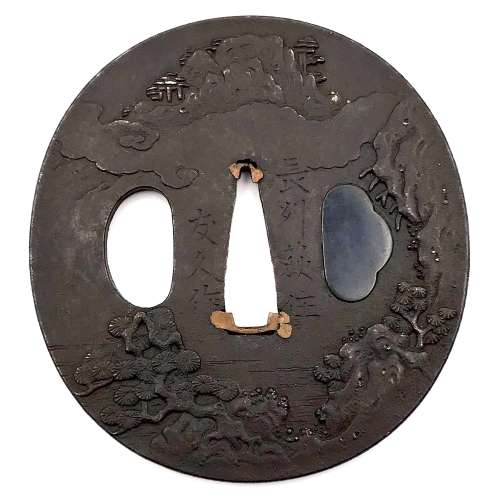
Iron tsuba of oval form carved with a landscape motif. Kogai-hitsu-ana plugged with shakudo. Sekigane of copper.
Signed: Chōshū Hagi-jū Tomohisa saku (長州萩住友久作).
Tomohisa, adopted son of Rokurō'emon, was 3rd generation master of Kawaji School from Hagi in Nagato (Chōshū), lived 1687-1743 [M. Sesko 'Genealogies', page 117].
Edo period, circa 1700. Dimensions: 71.1 x 66.8 x 2.9 mm For his adopted son Hisatsugu work see TSU-0103 in this collection. -

Iron tsuba of circular form with a branch of loquat (biwa) pierced in positive silhouette (ji-sukashi) and carved in marubori technique (marubori-sukashi). Kozuka and kogai hitsu-ana are plugged with shakudo.
Signature: Choshu Kawaji ju Hisatsugu saku. Chōshū school in Nagato province.
According to M. Sesko 'Genealogies' Hisatsugu was a 4th generation Kawaji School master from Chōshū (present day Nagato), with the name Gonbei, formerly Toramatsu, adopted son of Tomohisa (1687-1743) [page 117]. For Tomohisa work see TSU-0104 in this collection. -
 The Seven Gods of Good Luck in the Takarabune (ship of fortune) with a crane (the phoenix) above them.
The Seven Gods of Good Luck in the Takarabune (ship of fortune) with a crane (the phoenix) above them.Attributed to Katsukawa Shunshō, fl. 1726–92. Publisher: Uemura from Shiba (Edo). Marks "Publishers": U361|25-300: Uemura han (1793-1813). Marks "Artists, publishers...": Emiya Kichiemon (1688-1835). Artist signature absent. Looks very much like Pins #565 [p.223], but NOT the same. This exact design has not been found anywhere.



